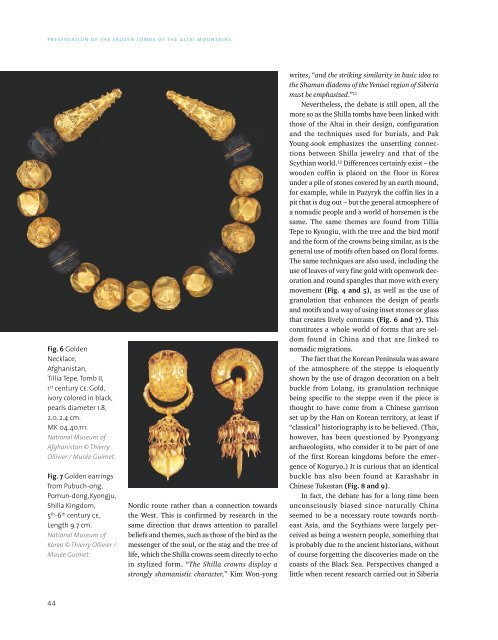Scythian Culture - Preservation of The Frozen Tombs of The Altai Mountains (UNESCO)
Create successful ePaper yourself
Turn your PDF publications into a flip-book with our unique Google optimized e-Paper software.
PRESERVATION OF THE FROZEN TOMBS OF THE ALTAI MOUNTAINS<br />
Fig. 6 Golden<br />
Necklace,<br />
Afghanistan,<br />
Tillia Tepe, Tomb II,<br />
1 st century ce. Gold,<br />
ivory colored in black,<br />
pearls diameter 1.8,<br />
2.0, 2.4 cm.<br />
MK 04.40.111.<br />
National Museum <strong>of</strong><br />
Afghanistan © Thierry<br />
Ollivier / Musée Guimet.<br />
Fig. 7 Golden earrings<br />
from Pubuch-ong,<br />
Pomun-dong,Kyongju,<br />
Shilla Kingdom,<br />
5 th -6 th century ce,<br />
Length 9.7 cm.<br />
National Museum <strong>of</strong><br />
Korea © Thierry Ollivier /<br />
Musée Guimet.<br />
Nordic route rather than a connection towards<br />
the West. This is confirmed by research in the<br />
same direction that draws attention to parallel<br />
beliefs and themes, such as those <strong>of</strong> the bird as the<br />
messenger <strong>of</strong> the soul, or the stag and the tree <strong>of</strong><br />
life, which the Shilla crowns seem directly to echo<br />
in stylized form. “<strong>The</strong> Shilla crowns display a<br />
strongly shamanistic character,” Kim Won-yong<br />
writes, “and the striking similarity in basic idea to<br />
the Shaman diadems <strong>of</strong> the Yenisei region <strong>of</strong> Siberia<br />
must be emphasized.” 11<br />
Nevertheless, the debate is still open, all the<br />
more so as the Shilla tombs have been linked with<br />
those <strong>of</strong> the <strong>Altai</strong> in their design, configuration<br />
and the techniques used for burials, and Pak<br />
Young-sook emphasizes the unsettling connections<br />
between Shilla jewelry and that <strong>of</strong> the<br />
<strong>Scythian</strong> world. 12 Differences certainly exist – the<br />
wooden c<strong>of</strong>fin is placed on the floor in Korea<br />
under a pile <strong>of</strong> stones covered by an earth mound,<br />
for example, while in Pazyryk the c<strong>of</strong>fin lies in a<br />
pit that is dug out – but the general atmosphere <strong>of</strong><br />
a nomadic people and a world <strong>of</strong> horsemen is the<br />
same. <strong>The</strong> same themes are found from Tillia<br />
Tepe to Kyongiu, with the tree and the bird motif<br />
and the form <strong>of</strong> the crowns being similar, as is the<br />
general use <strong>of</strong> motifs <strong>of</strong>ten based on floral forms.<br />
<strong>The</strong> same techniques are also used, including the<br />
use <strong>of</strong> leaves <strong>of</strong> very fine gold with openwork decoration<br />
and round spangles that move with every<br />
movement (Fig. 4 and 5), as well as the use <strong>of</strong><br />
granulation that enhances the design <strong>of</strong> pearls<br />
and motifs and a way <strong>of</strong> using inset stones or glass<br />
that creates lively contrasts (Fig. 6 and 7). This<br />
constitutes a whole world <strong>of</strong> forms that are seldom<br />
found in China and that are linked to<br />
nomadic migrations.<br />
<strong>The</strong> fact that the Korean Peninsula was aware<br />
<strong>of</strong> the atmosphere <strong>of</strong> the steppe is eloquently<br />
shown by the use <strong>of</strong> dragon decoration on a belt<br />
buckle from Lolang, its granulation technique<br />
being specific to the steppe even if the piece is<br />
thought to have come from a Chinese garrison<br />
set up by the Han on Korean territory, at least if<br />
“classical” historiography is to be believed. (This,<br />
however, has been questioned by Pyongyang<br />
archaeologists, who consider it to be part <strong>of</strong> one<br />
<strong>of</strong> the first Korean kingdoms before the emergence<br />
<strong>of</strong> Koguryo.) It is curious that an identical<br />
buckle has also been found at Karashahr in<br />
Chinese Tukestan (Fig. 8 and 9).<br />
In fact, the debate has for a long time been<br />
unconsciously biased since naturally China<br />
seemed to be a necessary route towards northeast<br />
Asia, and the <strong>Scythian</strong>s were largely perceived<br />
as being a western people, something that<br />
is probably due to the ancient historians, without<br />
<strong>of</strong> course forgetting the discoveries made on the<br />
coasts <strong>of</strong> the Black Sea. Perspectives changed a<br />
little when recent research carried out in Siberia<br />
44
















